
(Zoomable PDF.)
Though Portland has been justly praised for regularly making it through many calendar years with zero deaths of people biking, it is clearly the most dangerous of the four cities recognized as the nation’s bike-friendliest.
For the years 2009-2013, Portland’s fatality rate per bike commuter was 75 percent higher than the officially listed average for the League of American Bicyclists’ four “Platinum” cities: Portland; Fort Collins, Colo.; Boulder, Colo.; and Davis, Calif. Its reported collision rate per bike commuter was 94 percent higher.
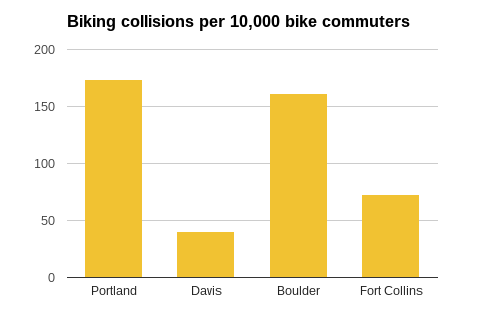
The figures above for Portland come from five-year averages, tracked by the City of Portland and Oregon Department of Transportation. The figures for other cities come from their most recent applications to the League, which asks only for the most recent year of fatality and collision data. However, Portland has been well above average in other one-year snapshots by the League, too.
Both the collision and fatality figures are based on the estimated number of daily bike commuters to work in each city. That’s an imperfect measure of the total amount of biking in a city, but it’s considered the best available because it’s tracked closely by the Census Bureau.
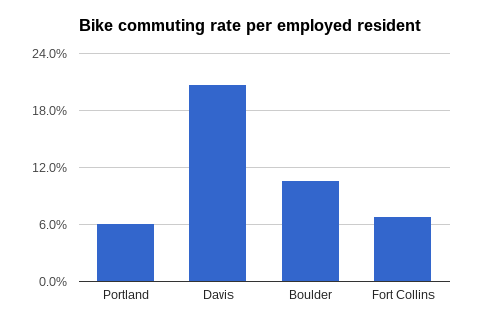
These figures don’t reflect collisions or fatalities from 2014 or 2015, including the death of Ryan Egge in 2014, at NE Cully and Killingsworth, or the death of Mark Angeles last week at SE Gladstone and Chavez. That’s because the final collision and ridership figures for 2014 aren’t available yet.
Advertisement
The number of reported collisions per estimated bike commuter in Portland has ticked up 16 percent since 2009, with the biggest rises in 2012 and 2013. But that’s not beyond the margin of error, so bike collision rates in Portland over the last few years since Portland received its “Platinum” designation would be best described as flat, like its rate of bike commuting.
On its ridership and fatality rates, Portland’s “key outcomes” more clearly resemble those in the cities the League rates as “Gold.” On its collision rates (which vary more by city because of different police reporting standards) Portland’s outcomes more clearly resemble those in the cities the League rates as “Silver.”
On Monday I asked Bill Nesper, vice president for programs at the League, if these figures lend any credence to the campaign by some Portland biking advocates for the League to downgrade Portland to “Gold” when the city’s status comes up for renewal next year.
“Davis is the real outlier here with over 20 percent of people biking and zero fatalities reported in the last application, so this effects those averages,” Nesper said in an email. “Like you, we’d definitely like to see more growth in bicycling. The Platinum BFCs are looking towards Diamond, which has a minimum of 15 percent ridership as well as minimum requirements for safety and comfort (public survey component).”
By those measures, only one city in the country, Davis, stands a chance of achieving “Diamond” status. If Davis were promoted to that status this year — its status is up for renewal in 2015 — the average performance of the League’s three remaining Platinum cities would indeed drop, but Portland would remain the most dangerous of the three.
In the larger picture, of course, every top-rated biking city in the country remains a dramatically safer place to ride a bicycle than almost anywhere in the United States. Here’s what the chart of fatalities looks like when you include the national average, too.
Update 11:55 pm: The Portland Bureau of Transportation responds with the following chart from the Alliance for Biking and Walking showing a different set of peers: The 50 largest U.S. cities. Among that group, Portland’s biking fatality rate is the best.
Active Transportation Manager Margi Bradway said Tuesday that a city like Fort Collins or Davis is less likely to see bike-related fatalities than Portland is because Portland has more large vehicles on many streets throughout the city rather than just a few, and because Portland’s role as a transportation hub adds to the amount of freight trucks.
However, Bradway added that as part of the city transportation bureau’s Vision Zero action plan, the city has secured a $150,000 grant from the Oregon Department of Transportation to study the best practices of major European cities, some of which have fatality rates even lower than those in Fort Collins or Boulder.
“We’re one of the safest if not the safest large cities in the country,” PBOT Safety Manager Gabe Graff said. “But that’s not acceptable to us, which is why we’re embarking on this Vision Zero action plan.”


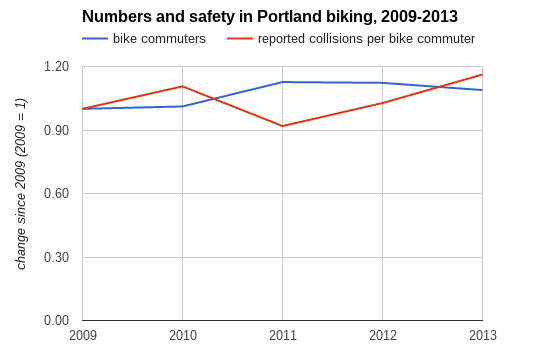
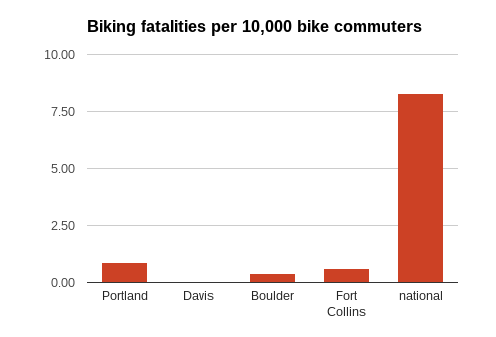
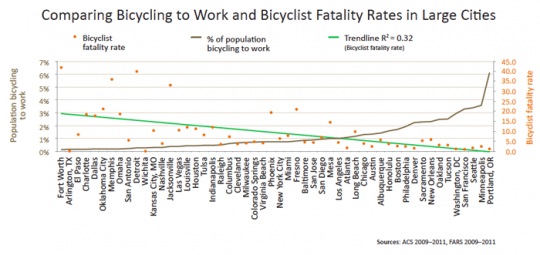
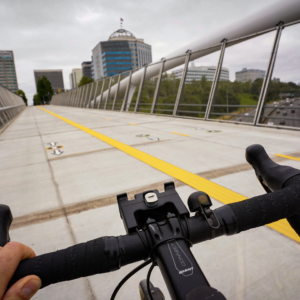


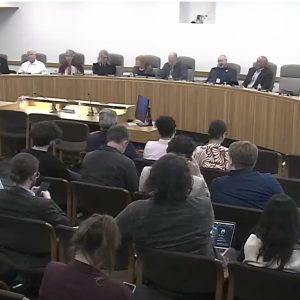
Thanks for reading.
BikePortland has served this community with independent community journalism since 2005. We rely on subscriptions from readers like you to survive. Your financial support is vital in keeping this valuable resource alive and well.
Please subscribe today to strengthen and expand our work.
Another fantastic piece of journalism and research from bikeportland! Thank you!
Who knows, perhaps Hales & Co. will take note, realize that their inclination to use bikeyness as a *brand* may need some heavy lifting on their part to be sustained?
“Journalism” is a bit much. A journalist might have asked, “What’s the difference between these cities?”
One answer: they’re college towns. The enrollment at UC Davis is 35,000 people, the enrollment at Colorado State University in Fort Collins is 31,000 people and the enrollment at University of Colorado at Boulder is 31,000 people.
Another answer: These cities are tiny compared to Portland. Davis is 66,000 and that includes the 25,000 students that live off campus. Fort collins has 152,000 (an unknown number of them are off campus students, presumably a large number) and Boulder has 103,000 people (also an unknown number of them off-campus students).
These are all much smaller towns, a large percentage of which are made up of college students, who are less likely to own a vehicle. Thus you have both a larger percentage of people biking and a smaller number of vehicle miles driven.
If this were a fantastic piece of journalism they would have pointed all of this out and focused more on apples-to-apples comparisons. This is cherry-picked data presented by a website that puts advocacy before journalism. Don’t put too much stock in it.
Gold, Platinum, Diamond, Unobtanium?
I can’t wait until the figures come back for the disaster that N. Williams has become. Nearly everyone I know who used to use N. Williams has stopped bike commuting, gotten hit, or both.
Figures?! I know who will not take a bike-car collision report. That is PPD.
As I have written before, I was struck by a SUV driver while riding north on Williams. The driver entered my right-of-way from the west on Fargo.
Adrenaline allowed me to ride away. But I was definitely injured. Plus bad vertigo for two months afterward.
As written here before, I call PPD non-emergency phone number and they refused to issue a report on my collision. It did not meet their monetary damages threshold. They just said, “Sorry”, and hung up.
So, that driver has no ticket or record on his driving license that he injured a vulnerable road user. (At the time I did not know about a citizen initiated ticket)
Several of my friends have also been injured by negligent drivers. Enough to tweak their body and bike but not enough for the PPD ambulance threshold.
NO WHERE ARE THESE INCIDENTS RECORDED IN ANY PORTLAND DEPARTMENTAL RECORD!!!
I am not unique. I wonder how many, many others do not have their bike-car collision recorded.
PPD sucks.
“I wonder how many, many others do not have their bike-car collision recorded.”
Or, parenthetically, whether this lamentable record by the PPB is comparable to, or different from, the record of police departments in these other cities to which our imperfect statistics are being compared?
I wonder where our Car Rights Activists (CRA: as ridiculous as the MRA) are (from the shaming article a few days ago) to explain how it’s worse when bikes do this to cars.
Take the traffic lane. Please. We would all be better off if nobody would tolerate bad infrastructure.
sorry if i missed it, but what are the raw total numbers of cyclists in each of these places?
just wondering if the cities are equal in any way for volume?
Good question. Here’s the spreadsheet with all my data:
https://docs.google.com/spreadsheets/d/1SLJpHBV7dvoLicwoKLIR4-m9IlNE9tCWah09mVbE1aE/edit#gid=0
I’ll add a link in the post above, too.
It does illustrate that other cities are pretty easily compared against each other in the number of commuters, but Portland has more than the other three combined.
Yes, the size of cities makes the comparison between these four almost useless. You’re essentially comparing 3 college towns to a top 30 city in the country.
Remind me to never travel anywhere except Davis, Boulder, and Fort Collins.
That national rate is terrifying!
Generally bicycle use and injury stats are both difficult to obtain and interpret. Generally, we really don’t know in PDX even how many people ride regularly and how many trips are taken by bike. The 6% mode share is based on census and survey results of self-reporting that bicycle is used as a primary means of commuting. So it doesn’t count anything about grocery stores, or taking kids to school or recreation. I haven’t read carefully on that national stat being used here but I would guess that high rate is based on something similar; that the methodology is dramatically under counting ‘cyclists’ because recreation or casual cycling and cycling by kids isn’t being counted.
The national stat on bike commuters used here comes from the same “what was your main mode last week?” question asked by the Census American Community Survey and averaged through the year. I agree that this is a pretty imprecise way to measure bike use, especially on the national scale where a much larger percentage of bike trips are purely recreational. Still, it’s once again the best standard for comparison that we have.
Portland is a mid-size urbanized city, >600,000 population plus the larger metro area. Boulder, Ft Collins and Davis are small cities/large towns, 66,000 to 150,000 population. Also, comparison of a single year’s data is unreliable, there have been recent years in Portland with zero fatalities too. Doesn’t mean we shouldn’t try to bring down our fatality rate, but there are reasons why Portland’s will tend to be higher over time than, say, Davis’.
All true and good points, John. For what it’s worth, I also looked at this document analyzing crashes in Davis over time to see if 2011 (the year the League’s Davis figures are based on) was an outlier. It doesn’t seem to be. This page on DavisWiki, which seems to be a fairly comprehensive and updated list of fatalities in Davis, doesn’t list anyone who died on a bicycle inside city limits during the last decade.
It also might be worth noting that German, Dutch, Danish and Swedish cities of comparable size to Portland also have lower bike collision rates, so it’s not as if all major metros are inherently more dangerous than all college towns.
Having lived in Boulder for many years (50 miles from Ft Collins) and traveling often to Davis I was about to make the important point that John does above. Those big university but otherwise small towns are not only much smaller but entirely different in makeup Now to reply to Michael’s comments about cities in wonderful bike-centric places in Northern Europe. While that’s useful info.I think the gist is Portland might be more meaningfully and usefully compared to other larger US cities. On that scale Portland rates pretty well for cycling safety, and well above places we some here fantasize are so much better for cycling, such as New York. This is not to justify carnage and danger by any means as we can do much, much better. But if feel if one read this article without the context of knowing those other college towns have nowhere even close to the amount of traffic (particularity heavy commercial traffic) that Portland has one would have the wrong impression. Far better to also show or stats next to US cities of similar size, volume and make up.
We’re better off than the impression this article makes. Yes we can be better – anytime anyone in the US gets cocky about their cities bike/ped infrastructure a quick visit to Amsterdam or Copenhagen will quickly blow through the hubris 😉 Take your bike and ride in almost any other bigger US city and you’ll quickly remember why Portland is still seen as a pretty good bike town despite the recent tragedies.
Certainly everyone is culpable, drivers and cyclists as well. I wish that I could get the 20% of bad drivers and bad cyclists to follow the rules and 80% of the accidents would be fixed.
“Certainly everyone is culpable, drivers and cyclists as well.”
false equivalency.
Yes, everyone should shape up and pay attention, but that is a matter of fairness rather than risk. Risk from someone biking in a sloppy fashion rarely rips another person’s leg off or sends them to the hospital. Yes, I know it happens on rare occasions, but it is important to keep the orders-of-magnitude differences in mind when making these kinds of statements.
As a former track racer, I am not afraid of getting hit by a cyclist. But I am still looking out for bad drivers. While the general public is getting better, there are still a fair number of rude, clueless and stupid drivers. And if you are driving with cyclist’s eyes, it is easier to avoid the stupid cyclists.
It is also very wrong that law enforcement has a very limited view of what is negligence vs an accident.
It would also be interested to compare the average miles ridden in each city per commute. I am guessing that commuting shorter distances = better statistics for # of collisions relative to the % of bike commuters. These comparisons to Portland look like smaller cities and I wonder if the commute distances are shorter. (Not that any of this is a reason that Portland doesn’t need to do better than we currently are to make the streets safer for everyone!)
Good point! Another factor might come into play: time of day. I’d imagine that commuting during high (car) traffic times increases the probability of being hit, assuming your riding on bike lanes and roadways and not dedicated bike paths.
Portland and Davis are VERY different. Davis is small and flat. Much of the riding in Davis is either done on campus, in the downtown, on dedicated bikeways, or the many low-car neighborhood streets. Downtown Davis is extremely small compared to Portland’s quadrants, and there are stop signs at pretty much every intersection, pedestrians galore, and a big highway and roads taking you easily around it. To get anywhere in Portland you have to drive through it, whereas Davis’ downtown is basically a destination itself – easily circumvented.
Dramatic fatalities express the need for safety. I’m scared of a painted bike lane remaining in traffic while a right turn lane for said traffic crosses this ‘middle’ bike lane. My answer: Keep the bike lane at the curb and/or onto sidewalk at such intersections. Bicycling fast through these is less safe than slowly or out of the way.
We could experiment in the dreaded ‘no parking’ signs posted where crosswalks most need visability. Bemoan another Lost Liberty! by removing a place to park! WOE to taciturn motorists unable to park!
Might as well stick on an Uber sign.
By Oregon law, you can’t park within 20 feet of a crosswalk at an intersection. Not that it’s enforced…
I think a bike lane to the left of a right-turn lane is far safer. I’d rather have road users sort themselves out as they approach an intersection, rather than when they are trying to move through it… most car drivers don’t expect a cyclist to appear on their right while they are in the middle of a turn, as they are focused on the area ahead as their vehicle moves forward.
We should assume both bike lane configurations are relatively unsafe and experiment with intersection design; whatever works to slow motorists making right turns. So too, my personal preference biking slowly through hazardous intersections seems safer if I use the sidewalk as would a pedestrian. — “Laws which pertain to bicycling are closer to those which pertain to pedestrians than those which pertain to motorists” is my guiding principle. Bicycling in traffic isn’t safer at higher speeds.
Remember police don’t necessarily report what you report to them, unless you ask for a incident number and follow up with a report request.
If you are involved in an accident with a car (driver), NEVER ride away. You are operating on adrenalin, you don’t know for sure what your injuries may be. Stay at the scene, get driver’s and car information, call police, ask for response to an injury accident. If driver leaves, that is a hit and run.
This.
So when will this “urgent meeting” take place? And will it address these things?
I think that much of your difference is to do with Portland being a larger city and therefore (a) longer average bike-trip lengths and (b) larger traffic volumes on biking routes. Most predictive crash models for bike crashes would include bike-km and adjacent traffic volumes as exposure measures; a simple per bike-user measure doesn’t capture these crash rate differences for such widely different urban areas.
I think your last chart put it in the best perspective: Portland’s crash rates are an order of magnitude better than the national average. Sure, they can always improve, but Portland is not a cycle safety problem.
Does it make sense to take into account miles driven when comparing these cities? I’m thinking that if there are more miles driven in one of the cities then there would be a greater chance for collisions if everything else was stable which it is not (ie street design, investment in safety, investment in enforcement, etc).
The LABs new half wheel pictograph really helps visually compare similar cities for the next series of status reranking…vs. what seemed more smoke and mirrors / FIFA board room in the early years of score reporting.
Portland’s citywide commute rate is really going to hit their platinum ranking hard (as it is almost below gold level), so other programs are going to have to really shine to Diamond level to make up for it. (Or time to de-annex East and SW Portland!)
Perhaps Mayor Hales is going to have to make an emergency declaration of doubling of parking rates and transit fares) and clearing parking lanes where bike lanes could go in order to save the platinum day.
“The LABs new half wheel pictograph really helps visually compare similar cities for the next series of status reranking…vs. what seemed more smoke and mirrors / FIFA board room in the early years of score reporting.”
Agreed! I too found it very helpful.
I live in Hawthorne. I see more skinny wheels acting aggressive around cars in traffic than I do anywhere else in town, while not wearing a helmet. I also see more vehicles being aggressive toward cyclist in this neighborhood.
What really gets me though. One street South and North of Hawthorne are designated cycle streets, yet, people without helmets continue to take up room on Hawthorne, providing the decline of their personal safety, which is not an issue for the city. Though it has become an issue for the city, because in America, common sense is not forethought.
Before anyone was riding a bike in Portland, before anyone was compiling the number of riders anywhere, I lived in Davis. It may surprise people in PDX, but the percentage of people riding in Davis is MUCH lower today than it was thirty years ago. I would estimate that it is about one-third today what it was then. And, the reality of motorists coming in from out of town daily (a huge problem in Portland) was nearly non-existent back then but is very real in today’s Davis.
A bigger surprise: back when the dominant form of transportation in Davis was the bicycle, there was almost no segregated infrastructure. One low-use bike path led west and a partial path led north. That’s it. There were a handful of bike lanes, but most folks eschewed those roads since they were mostly of the door-zone variety.
So, how did Davis get all those people on bikes? Simple, its police departments (city and university) adopted zero-tolerance for moving violations (yes, even for cyclists). When motorists are compelled to obey the law, it’s much easier to get people to ride. When the zero-tolerance stopped in the mid-80s, the bikes disappeared (relatively).
Unfortunately for me, having lived in a Golden Age, I am constantly depressed over the lack of people riding and annoyed at claims of “bike friendly” by such demonstrable failures as Portland. Good grief, for how long is 6% going to be considered success? Add in all the car-bound suburbanites and it’s even lower (and feels lower still).